2010 Yamaha SuperJet Review
Light and agile stand-up remains an enthusiast favorite
It comes as no big surprise that the Yamaha SuperJet returns for 2010 little changed from the craft that has now been on the water since the 2008 season. One reason, of course, is that the stand-up market has become a niche player in the grand scheme of things. No sense upgrading a model that sells little.
Another valid reason, however, is that the current model SuperJet is one heck of a stand-up model. It’s fun, agile, powerful, and has a nice intuitive inside-lean riding style.
Shape Shifter
Yamaha tweaked the SuperJet rather substantially in ’08. One change is that the hull is now flared forward of the craft’s midpoint, giving the boat a shape reminiscent of the previous stocker with aftermarket sponsons. It then slims as you flow aft, and the chines have been deepened. To that mix Yamaha added a new pump position, relocated about two inches aft, and a longer rideplate. The result is a bigger footprint in the water for the boat’s forward half, an increase in wetted surface area, and a turning style that is much more lean-in for cornering. In fact, if you’re used to the old-school SuperJet’s flat turning style, it’s dramatically different.
Yes, it is a little bit more like the agile-handling Kawasaki, but it also retains the SuperJet’s lighter feel. Comparing the two boats, I feel like I can still play around more on the SuperJet, throwing it into the corners or tossing it about on waves.
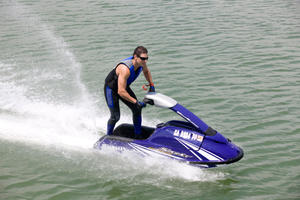 SuperJet riders may notice a less stable feel at higher speeds compared to pre-2008 models.
SuperJet riders may notice a less stable feel at higher speeds compared to pre-2008 models.There is a small tradeoff. That newfound lean-in cornering ability means the boat can feel a little bit less stable in straight-line speed runs. Riders will get used to it with time, but that narrow profile aft is the likely cause. I’ve also noted in the past that water can occasionally feel like it locks in the nose briefly, giving the boat a sudden feeling of plowing through the water. It’s minimal and infrequent enough, however, that I wouldn’t let either prevent me from buying the boat.
Overall it’s a fun, nimble feel that I find far superior to the old SuperJet, and a worthy competitor to the excellent-handling Kawasaki 800 SX-R.
Power Debate
No such tweaks have happened under the hood. Within the engine compartment you’ll find the familiar 701cc Twin cylinder with dual 38mm Mikuni carbs that has powered the boat seemingly forever. It’s powerful enough to propel the boat to a top speed in the mid-40s (expect a realistic 44-45 mph). Acceleration is also crisp and clean, with no hiccups in the powerband. Yes, most enthusiasts want more, but the aftermarket has responded with plenty of upgrades for those that want to push things further.
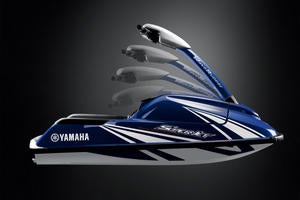 A spring-loaded handlepole lessens the load on the rider’s arms and back.
A spring-loaded handlepole lessens the load on the rider’s arms and back.Like Kawasaki, few amenities grace the industry’s most straightforward models. The handlepole is spring-loaded to lessen the load on a rider’s arms and back. The rider tray is thickly padded on both the bottom and gunwales to cushion lower legs, and features a small kick step at the stern for better leverage. Riders can quicken the steering response via an adjustable nozzle linkage.
And yes, it’s still predominantly blue at first glance. Yamaha’s trademark color has racing roots, and is still appropriate after all these years.
Get ‘Em While You Can
Speaking of years, they’re numbered for the SuperJet, as well as the Kawi 800 SX-R. The boats are already banned from sale in California and New York because of the emissions of their old-school two-stroke engines. That ban will go nationwide in 2012. Both manufacturers have indicated that models will still be for sale for race-only use. For average enthusiasts, however, no new model will likely exist in less than 18 months unless one, or both manufacturers elects to invest in a four-stroke engine alternative.
Personally, I’ll hate to see the SuperJet go away. I’ve always liked its playful personality for freestyle riding, and love the way it responds to a rider’s input.
Sure, it’s a niche player. But I’ve watched countless sit-down enthusiasts try one, only to quickly proclaim they needed to expand their arsenal.
Try one and you might agree.
| 2010 Yamaha SuperJet Specs | |
| Length | 88.2 inches |
| Beam | 26.8 inches |
| Dry Weight | 291 lbs |
| Engine | Twin cylinder, two-stroke |
| Displacement | 701 cc |
| Bore and Stroke | 81mm x 68 |
| Compression Ratio | 7.2:1 |
| Rated Horsepower | N/A |
| Fuel Capacity | 4.8 gal. |
| Colors | Atomic Racing Blue |
| Price | $7,499 |
Related Reading
2010 Yamaha WaveRunner Lineup Preview
2010 Kawasaki Jet Ski 800 SX-R Review
Get PersonalWatercraft.com in your Inbox!
Like PersonalWatercraft.com on Facebook
Comments
Most Popular

2025 Yamaha JetBlaster PRO 2-Up Review

2024 Kawasaki Jet Ski STX 160X Review

Remembering the Sea-Doo XP

Whatever Happened to the Wetbike?

2025 Yamaha JetBlaster Review




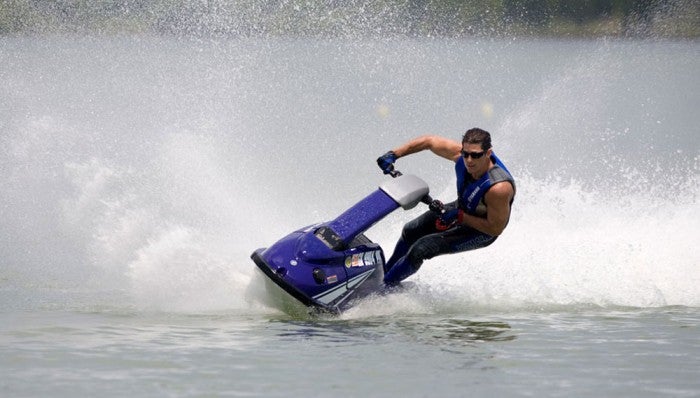
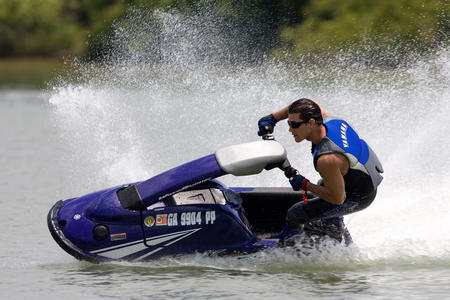
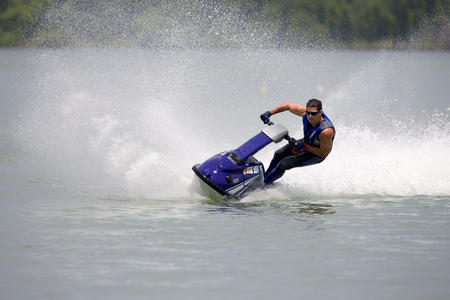









 Your Privacy Choices
Your Privacy Choices